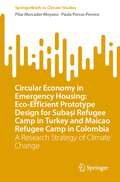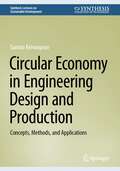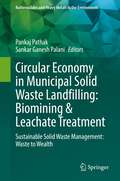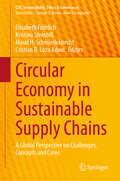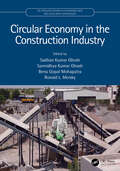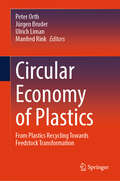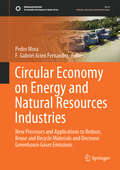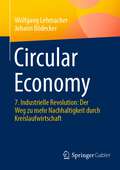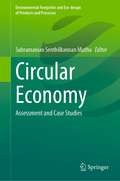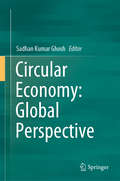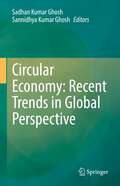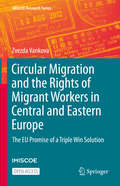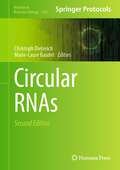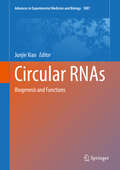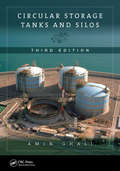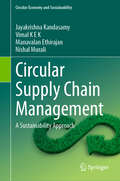- Table View
- List View
Circular Economy in Emergency Housing: A Research Strategy of Climate Change (SpringerBriefs in Climate Studies)
by Pilar Mercader-Moyano Paula Porras-PereiraIn recent years, there has been an upsurge in the number of forced displacements due to natural disasters, armed conflicts, and pandemics, which has favoured an increase in the number of temporary accommodations. Although the provision of shelter after an emergency situation is one of the priorities of humanitarian aid, the reality is that the conditions in which people live in a situation of forced displacement are absolutely precarious and overcrowded. Nowadays, this type of housing tends to have a short lifespan, deepening the environmental impact and the generation of waste. Likewise, added to this great problem is the linear economic system implemented worldwide, which also causes a high rate of waste.This investigation develops an eco-efficient design protocol that determines the basic premises in any emergency situation, therefore avoiding the precarious nature to which those in forced displacement are exposed. Moreover, the research investigates different constructive solutions that can respond to situations of natural catastrophes or humanitarian disasters where emergency housing is needed as well as the possible alternatives from the point of view of circular economy. Eco-efficient and environmentally correct solutions are sought, which can be adaptable to the different scenarios where emergency housing may be needed, thus creating a rapid, easy, functional, and environmentally correct architecture, adaptable to these types of situations. The study shows that the factors that characterize emergency architecture can be an example of where the issues around the sustainability factor are applied in a practical way. The main objectives of this study are to develop an eco-efficient design protocol which determines the basic premises in any emergency situation and to find eco-efficient and environmentally correct solutions, adaptable to different scenarios, which have similar climatic characteristics, and where emergency housing may be needed, thus creating a type of ephemeral architecture but sensitive to the user to whom it is intended and in accordance with the optimal conditions of habitability.
Circular Economy in Engineering Design and Production: Concepts, Methods, and Applications (Synthesis Lectures on Sustainable Development)
by Samira KeivanpourThis concise text provides the concepts, methods, and application examples for integrating sustainability into engineering design and production. It discusses the role of sustainability in the value creation processes of various enterprises and different tools and methods for systematic incorporation of social and environmental aspects into the product's life cycle. The following topics are covered: sustainable development in engineering systems and the life cycle concept, norms and standards in the sustainable development and integration of socio-economic assessment into technical valuation, production systems, management of the production systems based on circular economy principles, ecodesign practices, and value creation and innovative design in the circular economy. Provides a concise guide for engineering students for applying circular economy practicesPresents examples and short case studies for understanding the methods and toolsFacilitates understanding and application of the life cycle perspective in product manufacturing and green engineering
Circular Economy in Municipal Solid Waste Landfilling: Sustainable Solid Waste Management: Waste to Wealth (Radionuclides and Heavy Metals in the Environment)
by Pankaj Pathak Sankar Ganesh PalaniThis book will serve as a ready reckoner of contemporary information regarding municipal solid waste landfill biomining, treatment of landfill leachate and heavy metals in a single platform. The academicians, researchers, and students at master’s and doctoral levels will be able to understand the current trends in municipal solid waste landfill operations, which will help in augmenting their research. Construction of new landfills requires huge monetary investments, which can be avoided if old landfills were bio-mined for resources and the space can be re-used as new landfills. Landfill leachate is a hazardous waste which needs proper treatment that could generate value-added products such as clean energy and biofertilizers. In this book, each chapter would provide the background, methodology, and relevant calculations for sustaining landfill operations. Also, the case studies based on best practices in municipal solid waste landfilling are discussed in this book.
Circular Economy in Sustainable Supply Chains: A Global Perspective on Challenges, Concepts and Cases (CSR, Sustainability, Ethics & Governance)
by Elisabeth Fröhlich Kristina Steinbiß Maud H. Schmiedeknecht Cristian R. Loza AdauiCircularity is one of the most promising innovative business models for tackling the challenges posed by climate protection, resource conservation and biodiversity conservation. Circularity requires changed business structures; therefore, it is necessary to adapt existing approaches and reconcile economic and ecological interests. By focusing on the importance of horizontal integration and cross-company cooperation, this book offers valuable insights to help companies generate cross-industry synergy and symbiosis effects and secure competitive advantages along sustainable supply chains. The emphasis is on an expanded understanding of the various R principles, and on theoretical and practical application examples that help to prepare corporate business models for the ecological and social challenges of global supply chains. Given its scope, the book represents an indispensable guide for companies worldwide that want to contribute to sustainable development by adopting circular business models. It analyses the drivers and challenges of implementing these models and presents concepts and insights from pioneering companies in the circular economy, providing a global perspective for managers and researchers alike.
Circular Economy in the Construction Industry (The Circular Economy in Sustainable Solid and Liquid Waste Management)
by Sadhan Kumar Ghosh Sannidhya Kumar Ghosh Benu Gopal Mohapatra Ronald L. MerskyCircular Economy in the Construction Industry is an invaluable resource for researchers, policymakers, implementers and PhD and Masters-level students in universities analyzing the present status of Construction and Demolition Wastes (C&DW) management, materials development utilizing slag, fly ash, HDPE fibre, geo-wastes, and other wastes, green concrete, soil stabilization, resource circulation in construction sectors, success in experimentation & commercial production, future needs, and future research areas. While huge C&DW is wasted by dumping, there is potential of recycling preventing greenhouse gas (GHG) emissions and environmental pollution as well as creating business opportunities. Circularity of resources in the construction industry can contribute to a more secure, sustainable, and economically sound future through proper policy instruments, management systems, and recycling by selecting the following: Supply chain sustainability and collection of C&D Wastes, Appropriate separation and recycling technology, Enforcement of policy instruments, Productivity, quality control of recycled products and intended end use, Economic feasibility as business case, commercialization, generating employment. This book addresses most of the above issues in a lucid manner by experts in the field from different countries, which are helpful for the related stakeholders, edited by experts in the field.
Circular Economy of Plastics: From Plastics Recycling Towards Feedstock Transformation
by Jürgen Bruder Peter Orth Manfred Rink Ulrich LimanThis unique book provides comprehensive and holistic information on the circular economy of plastics - products and their design for circularity, markets and producer responsibility, recovery of wastes and resource responsibility, and plastics manufacturing with circular feedstocks. The central part of the book is on circularity and circular feedstocks, embedded in a framework of chapters on the relevant properties of plastic as a material, its ecosystems and mass streams across Europe on the one hand and of chapters on Life Cycle Analysis and Product Carbon Footprint, on digitalisation, logistics, and standardization on the other hand. Comprehensive information is provided on relevant EU-regulation and on national regulation in Europe, too. A knowledge body contains information on relevant associations and networks, on recent studies on the topics mentioned, and an extensive glossary. Thus the book is a compendium of information on the dynamically evolving realm of the circular economy providing insight and clarity into complex and puzzling structures and positions. The book addresses professionals in a wide range of industries together with scholars and students in science and technology as wells as policy makers, authorities, and the media.
Circular Economy on Energy and Natural Resources Industries: New Processes and Applications to Reduce, Reuse and Recycle Materials and Decrease Greenhouse Gases Emissions (Sustainable Development Goals Series)
by Pedro Mora F. Gabriel Acien FernandezThis book masterfully bridges the gap between science and industry, offering readers invaluable insights into the technological advancements shaping our world. Amidst a profound industrial transformation aimed at minimizing environmental impact, this work highlights the pivotal role of reducing energy consumption and material waste. It aligns closely with the United Nations Sustainable Development Goals, encapsulating the global ambition for the coming years. The narrative delves into myriad examples of industrial evolution, showcasing how various sectors, especially energy (including electricity and oil & gas) and natural resource exploitation, are revolutionizing their processes to lessen their environmental footprint. Furthermore, each chapter of the book equips readers with the knowledge to spearhead innovative solutions tailored to these evolving processes, making it an essential resource for anyone committed to driving sustainable industrial advancements.
Circular Economy: 7. Industrielle Revolution: Der Weg zu mehr Nachhaltigkeit durch Kreislaufwirtschaft
by Wolfgang Lehmacher Johann BödeckerWenn wir unseren Lebensstandard und Lebensraum erhalten wollen, müssen wir radikal umdenken und unsere Wirtschaft neu gestalten. Gefragt ist eine zirkuläre, umwelt-zentrierte Wirtschaft. Nur wenn es gelingt, bei unserem Handeln auf den Gesamtkomplex Leben Rücksicht zu nehmen, werden wir unseren Planeten erhalten können – und damit unseren Wohlstand und unsere Lebensqualität langfristig sichern.Das Buch beschreibt sehr anschaulich, was Circular Economy für Unternehmen und die gesamte Wirtschaft bedeutet. Zahlreiche Beispiele und strategische Umsetzungsideen bieten einen Einblick in die erfolgreiche Realisierung.
Circular Economy: Assessment and Case Studies (Environmental Footprints and Eco-design of Products and Processes)
by Subramanian Senthilkannan MuthuThis book highlights the notion of Circular Economy under the umbrella of Sustainability because of the widespread momentum it is gaining. Today the whole world is certainly in emergent need of an alternative system to traditional economy which is linear, i.e. make, use and dispose to get rid-off the waste and very important to ensure continuous use of resources, which is possible by the advent of circular economy. A circular economy aims to utilize the resources in use for as long as possible, extract the maximum value from them during use, then recover and regenerate products and materials at the end of each service life vis-à-vis traditional linear model. This book discusses circular economy in terms of assessment with various case studies.
Circular Economy: Global Perspective
by Sadhan Kumar GhoshA circular economy is an alternative to a traditional linear economy (make, use, dispose) in which we keep resources in use for as long as possible, extract the maximum value from them whilst in use, then recover and regenerate products and materials at the end of each service life. Circular economy (CE) is important towards sustainable development, resources circulation and conservation, involving closing of material loops and cascading used resources, to prevent waste occurrence, and transforming the resulting residual streams into new (secondary) resources. Strategies and legislative framework for waste management are important steps for development of a more CE where resource efficiency becomes the key driver for both economic growth and environmental protections. A few countries achieved good results implementing CE as a replacement of the linear economy. Resource managers and planners should thoroughly identify factors to implement CE for societal benefits. This book presents how resource consumption is minimized with rational use based on 3Rs, legislative framework and government supports towards implementing CE initiatives, example of best practices, future plans and targets in different countries those are helpful for researchers, planners and implementers.
Circular Economy: Impact on Carbon and Water Footprint (Environmental Footprints and Eco-design of Products and Processes)
by Subramanian Senthilkannan Muthu Aldo Alvarez-Risco Shyla Del-Aguila-ArcentalesThis book highlights ways to evaluate circular economy using global standard and footprints the way global firms are using to ensure the measurement of the impact. It presents various case studies from different sectors with the efforts made to contribute to circular economy and at the same time its contribution to minimize carbon and water footprints.
Circular Economy: Recent Trends in Global Perspective
by Sadhan Kumar Ghosh Sannidhya Kumar GhoshThis book presents the advantages of the circular economy as a powerful - and inevitable - model for tackling the current challenges against shrinking resources and establishing the resource efficient economy. The experienced contributors present the status and strategies of circular economy implementation in several countries with hands on experience to protect the environment while promoting the circular economy through legislative requirements, best practices adopted and popularizing the idea of circulation of resources amongst the researchers & academia, policy makers, industry, and the general public at large. The book advocates model that consists of designing products and processes with a view to endlessly recycling them evolving a greater scope of sustainable development.
Circular Migration and the Rights of Migrant Workers in Central and Eastern Europe: The EU Promise of a Triple Win Solution (IMISCOE Research Series)
by Zvezda VankovaBy adopting a rights-based approach, this open access book sheds light on the different legal and policy instruments that have been adopted to implement circular migration policies in the EU and their consequences for the rights of migrant workers. It contributes to the understanding of the meaning of this concept in general, in the EU, as well as more specifically with regard to its Eastern neighbourhood. The book provides a comprehensive overview of the formation and implementation of the EU’s circular migration approach that has developed through both EU and national instruments on the basis of comparative case study analysis of Bulgaria and Poland’s migration law and policy. Furthermore, by applying legal empirical research methods, it draws conclusions about the policy outcomes from the implementation of the various migration instruments falling under the circular migration umbrella and shows the consequences for the rights of migrant workers as a result of the application of different policy options.Along with its value to an academic audience, the book can be used by policy makers at the EU, international and national level as well as international organisations and NGOs working in the field of migration law and policy.
Circular RNAs (Methods in Molecular Biology #2765)
by Christoph Dieterich Marie-Laure BaudetThis second edition details new and updated methods on circular RNA. Chapter guide readers through circular RNA purification, in silico characterization, circRNA detection, sequence validation, quantification , techniques related to gain- and loss-of-function approaches, circular RNA synthesis, split ligation, engineering, nanoparticle packaging, RNA modifications on circular RNA biogenesis, RNA translation potential, and vaccines based on circular RNAs. Written in the highly successful Methods in Molecular Biology series format, chapters include introductions to their respective topics, lists of the necessary materials and reagents, step-by-step, readily reproducible laboratory protocols, and key tips on troubleshooting and avoiding known pitfalls. Authoritative and cutting-edge, Circular RNAs, Second Edition aims to ensure successful results in the further study of this vital field.
Circular RNAs: Biogenesis And Functions (Advances in Experimental Medicine and Biology #1087)
by Junjie XiaoThis book provides an essential overview of the rapidly advancing field of circular RNAs – newly discovered RNAs that are generated by back-splicing precursor mRNA and perform regulatory functions in many biological processes. Although many aspects of circular RNAs’ biology and mechanisms of gene regulation remain unclear, they have been found to be abundant, evolutionally conserved, and stable in cells; further, they have numerous potential functions. The book consists of eight parts:1) An overview of circular RNAs, 2) Bioinformatics for circular RNAs, 3) Biogenesis of circular RNAs, 4) Molecular mechanisms and gene regulation of circular RNAs, 5) Circular RNAs as potential disease biomarkers, 6) Circular RNAs and human diseases, 7) Circular RNAs in Plants and in Archaea, and 8) Future prospects. Given its focus, the book will be especially useful for researchers and students in the fields of biochemistry, molecular biology, cell biology, and medicine.
Circular Storage Tanks and Silos
by Amin GhaliThis book presents practical methods for the analysis and design of circular concrete tanks. The methods can also be used for silos, pipes, or any circular shells subjected to arbitrary axially symmetrical loading, and also deal with the more general problem of beam on elastic foundation. The book includes a new chapter on the design of construction of circular tanks, comes with new easy-to-use computer programs, and provides design examples that include post-tensioned concrete walls, footings, floors and roofs, and liquid-tight connections between these components.
Circular Supply Chain Management: A Sustainability Approach (Circular Economy and Sustainability)
by Jayakrishna Kandasamy Vimal K E K Manavalan Ethirajan Nishal MuraliThis book provides fundamental knowledge of theories on the circular economy and circular supply chain management. It also discusses theories that have been developed or adopted in circular economy research. Traditional supply chains organizations have felt the importance of transforming their activities to become more circular. This book provides insights into the need for adopting circular supply chain practices and the circular business models they can adopt. Barriers that supply chain organizations will encounter in their efforts to expediate the transformation, and the drivers that they will need to achieve these goals, are elaborated in the book. The key factors that help in the decision-making process and modalities involved in modelling the circular chains are also discussed. These will be of great value to managers and other stakeholders. Additionally, the role of I4.0 technologies in future supply circular chains is elucidated. This book also offers solutions to supply chain organizations for achieving the sustainable development goals. Case studies and illustrations are provided in each chapter for easy understanding of theory to practice.
Circularity Assessment: Accountability Towards Sustainability
by Seeram Ramakrishna Rashmi Anoop PatilThis open access book attempts to provide a perspective on the circularity assessment at different levels of the systemic hierarchy and advocates better resource management for a sustainable future. It demonstrates how relevant circularity indicators are used for quantifying the extent of circularity of each level. Illustrative case studies that discuss the process of quantitatively interpreting progress towards circularity are provided. This work caters to a broad readership inclusive of governance, basic research, engineering, and business stakeholders. The conclusion signifies the role of consumer community in achieving circularity.
Circularity of Cementitious Materials: A Practical Approach (Emerging Materials and Technologies)
by Christian PagliaRecycling of materials in building and infrastructure applications are global concerns driven by natural resource preservation needs of modernized countries and sustainable development of emerging countries. This practical book explores the strategies necessary for successful recycling of cement-based materials to achieve sustainable and long service life. It investigates recycled cementitious materials to ensure decisive implementation and meet industry and societal challenges. Presents the state of the art in recycling one of the most used materials in today’s construction sector Covers construction and demolition waste and recycled concrete, UHPC, and road base material Aimed at readers in materials, civil, and construction engineering, this book offers guidance to professionals and researchers developing strategies for sustainable application of cement-based materials.
Circularly Polarized Luminescence of Isolated Small Organic Molecules
by Tadashi MoriThis book collects all the latest advances in the leading research of the circularly polarized luminescence (CPL) of small organic molecules. Compared with that of lanthanide-based fluorophores, the research into the CPL of small organic molecules is still at the developmental stage for their relatively smaller dissymmetric factors, but has been a source of widespread attention recently. The book includes the state of the art of the discoveries in CPL organic molecules, such as helicenes, biaryls, cyclophanes, boron dipyrromethene dyes, and other chiral molecules, mostly in their isolated states, covering all possible chiral substances for future applications. This book also highlights the recent development of CPL instruments as well as time-resolved circular dichroism spectroscopy, to facilitate the further development and future design of CPL molecules.
Circulating Fluidized Bed Boilers: Design, Operation and Maintenance
by Prabir Basu· Explains operation and scientific fundamentals of circulating fluidized bed (CFB) boilers · Outlines practical issues in industrial use · Teaches how to optimize design for maximum reliability and efficiency · Discusses operating and maintenance issues and how to troubleshoot them This book provides practicing engineers and students with insight into the design and operation of circulating fluidized bed (CFB) boilers through a combination of theoretical concepts and practical experience. An emphasis on combustion, hydrodynamics, heat transfer, and material issues illustrates these concepts with numerous examples from actual operating plants. The relevance of design and feed-stock parameters to the operation of a CFB boiler are also examined, along with their impacts on designs of mechanical components, including cyclones, air distributor grids, and solid recycle systems. This versatile resource explains how fluidized bed equipment works and how the basic principles of thermodynamics and fluid mechanics influence design, while providing insight into planning new projects, troubleshooting existing equipment, and appreciating the capabilities and limitations of the process. From hydrodynamics to construction and maintenance, the author covers all of the essential information needed to understand, design, operate, and maintain a complete fluidized bed system. It is a must for clean coal technology as well as for biomass power generation.
Circulating Nucleic Acids in Early Diagnosis, Prognosis and Treatment Monitoring: An Introduction (Advances in Predictive, Preventive and Personalised Medicine #5)
by Peter B. GahanDNA and RNA fractions can be isolated from a variety of body fluids including whole blood, serum, plasma, urine, saliva and cerebrospinal fluid from both patients and healthy individuals. Such isolates can be exploited in the early detection of clinical disorders, stratification of patients for treatment, treatment monitoring and clinical follow-up In addition, the use in fetal medicine allows the early detection of fetal sex, Rh factor and aneuploid disorders as well as following both fetal and premature born infant development. This volume is intended as a primer for those who are interested in entering the field of circulating nucleic acids. The areas covered in this volume include: · Background and general biology of circulating nucleic acids · Methodology · Applications of circulating nucleic acids · Quality Assurance · Ethics
Circulating Nucleic Acids in Plasma and Serum: Proceedings of the 6th international conference on circulating nucleic acids in plasma and serum held on 9-11 November 2009 in Hong Kong.
by Peter B. GahanDNA and RNA fractions have been isolated from the whole blood, serum, plasma, the surface of blood cells, urine, saliva and spinal fluid from both healthy individuals and clinical patients. Recent developments are presented concerning the isolation, quantification and analysis of these molecules and their use in the identification of specific nucleic acid fragments related to a variety of clinical disorders thereby permitting their early diagnosis and prognosis.
Circulating Nucleic Acids in Serum and Plasma – CNAPS IX (Advances in Experimental Medicine and Biology #924)
by Bernd Schmidt Peter B. Gahan Michael FleischhackerThe book will present the progress made since the last meeting in fall 2013 concerning the analysis of circulating extra-cellular nucleic acids. There are a modest number of laboratories involved in this field, nevertheless the number of papers published by researchers is extensive. The articles which will be published in this meeting report will be a valuable contribution for researchers and research students alike and will help them to stay on top of the developments in different research areas and to ,,cross borders" between them.
Circulating Tumor Cells in Breast Cancer Metastatic Disease (Advances in Experimental Medicine and Biology #1220)
by Roberto PiñeiroThis book is aimed to summarise the key aspects of the role of circulating tumour cells (CTCs) in breast cancer, with special attention to their contribution to tumour progression and establishment of metastatic disease. We aim to give a clear overview of the knowledge about CTCs, framed in the context of breast cancer, by analysing basic and clinical research carried out so far. In a broader sense, we will address what are the main clinical needs of this disease based on its molecular heterogeneity (subtypes) and lay out the knowledge and understanding that CTCs are giving about it and how they are contributing and can still improve the better monitoring and management of breast cancer patients. We will discuss the evidences of the use of CTCs as a tool to monitor cancer progression and therapy response, based on the prognostic and predictive value they have, as well as a tool to unravel mechanisms of resistance to therapy and to identify new biomarkers allowing to predict therapy success. Moreover, we will analyse the main aspects of ongoing clinical trials and how they can contribute to determine the clinical utility of CTCs as a breast cancer biomarker. We will also touch upon general knowledge or basic notions of the biology of the metastatic process in epithelial cancers, in order to understand the origin and biology of CTCs. In this sense, we will pay special attention to EMT (epithelial to mesenchymal transition), dormancy and minimal residual disease, three key aspects that determine the outcome of the disease. We will also cover general aspects on the isolation and characterization techniques applies to the study of CTCs, and also the possibilities that the study of CTCs, as a biomarker with biological function, is opening in terms of understanding the biology of metastatic cells and the identification of therapeutic targets based on the functional and molecular characterization of CTCs. Lastly, we will try to foresee the future of CTCs in terms of clinical application and implementation in the clinical routine.
